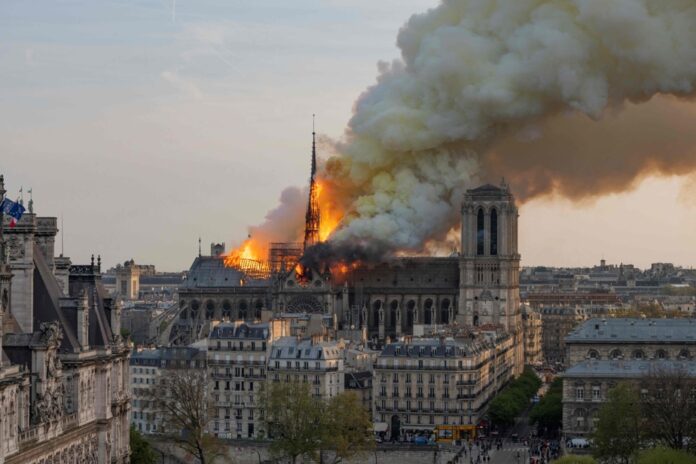(Paris) Gigantic flames, images that go around the world… and residents poisoned with lead? Four years after the Notre-Dame de Paris fire, a French judge is investigating a complaint accusing the authorities of not having taken all the precautions to avoid contamination.
An association for the defense of health in connection with work and the environment, the CGT union and two parents of students obtained, via a complaint with civil action filed in June 2022, the appointment of a judge of Parisian investigation, AFP learned on Wednesday from a source familiar with the matter, confirmed information from a judicial source.
On April 15, 2019, a gigantic fire ravaged the cathedral, a masterpiece of Gothic architecture, causing the collapse of its framework, its famous spire, its clock and part of its vault, under the gaze of millions of people around the world.
In the blaze, 400 tonnes of lead from the roof and spire of Notre-Dame went up in smoke, i.e. “ nearly four times the annual lead emissions into the atmosphere, in the whole of France ”, note the complainants.
If the risk related to air pollution is quickly dismissed, residents and associations quickly worry about the fallout on the ground of this toxic heavy metal, which can be brought home under their soles and be ingested by children.
“There is no concentration in the blood that is safe,” warns the World Health Organization (WHO).
Twelve days after the fire, the police headquarters recommends that residents clean their homes. She points out that she has temporarily banned certain areas from the public, in particular the gardens around the cathedral showing traces of lead.
In the summer of 2019, the forecourt was closed and the construction site suspended for a few weeks, after various alerts on the lead levels measured. Upon reopening, new protective measures are taken for workers.
At the same time, a “deep cleaning” was carried out “as a precaution” in certain schools adjoining the cathedral, followed by new measures which led to a postponement of the start of the school year for a few days in five schools.
The town hall of Paris ensures that there is “ no risk for the health ” of the children, on the basis of samples taken one month after the fire. The interpretation of the results is contested by associations of local residents.
In July 2021, the government agency Public Health France also indicated that the fire did not cause a “significant” increase in the concentration of lead in the blood of local children.
For the plaintiffs, “ despite the scale of the fire and the knowledge of the risks of pollution and contamination […], no special precautions were taken by the authorities concerned for more than three months after the fire ”, endangering “ children (in nurseries and schools), residents and workers (in the neighborhood and at the cathedral) ”.
According to them, the Regional Health Agency, the police headquarters, the town hall of Paris or the Ministry of Culture should have taken the most drastic measures just after the blaze.
They are also concerned about the increased dissemination of lead attributed to the titanic construction site launched just after the fire, as well as the lack of protective measures for the personnel involved in the work.
“ We ask that investigations be carried out quickly so that responsibilities are cleared concerning the contamination of children attending school or living near Notre-Dame and concerning the massive exposure of workers present on the construction site ”, commented the lawyer for the complainants, Me François Lafforgue, “satisfied” with the opening of a judicial investigation on this subject.
A judicial investigation is also still in progress to try to determine the causes of the fire.
The reopening of the building, which before the fire welcomed nearly 12 million visitors, 2,400 masses or offices and 150 concerts per year, is planned for 2024.
The associations are concerned to see rebuilt identically and with the same materials, therefore lead, the cathedral restored in the 19th century. The European Union has also considered restricting the use of this material.


















